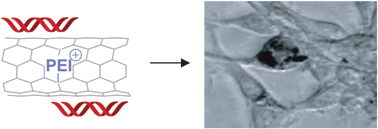 New Nanoscale Communication
New Nanoscale Communication
Polyethylenimine–carbon nanotube nanohybrids for siRNA-mediated gene silencing at cellular level
Stéphanie Foillarda, Guy Zuber and Eric Doris
Nanoscale DOI:10.1039/C0NR01005G
Carbon nanotube (CNT) based structures which can act as ‘nanohybrid vehicles’ for the delivery of functional molecules into cells have been developed by scientists in France.
Synthetic interfering RNA (siRNA) is able to inhibit the expression of a targeted gene by triggering enzymatic and sequence-selective degradation of the corresponding mRNAs, which holds great promise for the highly selective treatment of medical disorders at a genetic level. However, nucleic acids require a ‘delivery vehicle’ to take carry them through the cellular membrane and to the sites where they are required. The CNT hybrid nanostructure developed by this group is intended to do exactly this.
Eric Doris and co-workers at CEA, Service de Chimie Bioorganique et de Marquage, covalently modified short CNTs (~200 nm) with the cationic polymer polyethylenimine (PEI), which were then able to bind siRNA. The intention was to build a nanostructure which could enter cells by endocytosis but escape endosomal capture to increase the biological activity of the payload. They appear to be successful in this as they show that their system performs better than a reference lipid carrier.
To read this article, click here.










